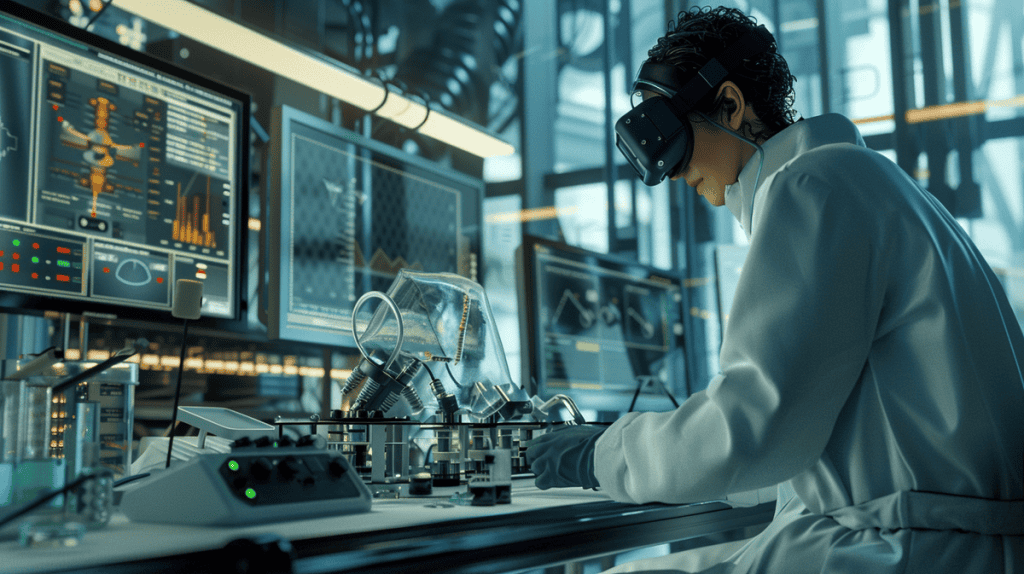Velocity measurement isn’t only a buzzword. It’s a key asset in various industries. With years of experience as an engineer, I’ve witnessed firsthand how precise velocity measurements can make or break a project.
So, you should grasp this idea if you want to improve processes, optimize systems, and hit your objectives. So how does velocity measurement work?
Fundamentals of Velocity Measurement
Velocity measurement is a foundational concept in thousands of scientific and engineering applications. I’ve studied velocity measurement for years, and I can confidently tell you it’s an essential concept to understand motion in our world.
Velocity is the measure of the change in position of an object. It isn’t just the quantitative value of how fast something is moving, but also where it’s moving. This is what makes it a vector quantity distinct from speed, which is a scalar quantity.
The basic velocity formula is distance divided by time. For example, when you travel 60 miles in an hour, you’re calculating velocity (60 miles per hour).
We use different units to measure velocity:
- SI system: meters per second (m/s)
- Imperial system: feet per second (ft/s), miles per hour (mph)
It’s important to distinguish between speed and velocity:
- Speed: A scalar value indicating how fast an object is moving
- Velocity: A vector quantity indicating how fast and in what direction an object is moving
- Speed is always positive, but velocity can be either positive or negative
- Average speed involves total distance, while average velocity considers displacement
Velocity measurement is a concept you’ll use in a variety of applications. Whether you’re running a simple physics experiment or designing a complex traffic management system, you’re simply quantifying and analyzing motion. When you understand these basics, you’ll be able to understand more complex concepts in mechanics and dynamics.
Methods for Measuring Velocity

In my experience during my career, I’ve seen many different ways to measure velocity, and each method comes with its own set of pros and cons. Let’s discuss the most common methods.
Kinematic methods track the position of an object over time. This can be as simple as using a stopwatch and a measuring tape, or it can involve using high-speed cameras and motion tracking software.
Dynamic methods use the relationship between force, mass, and acceleration. Typically, you’ll use a sensor to measure the force applied (or acceleration) and then use that data to calculate velocity.
Physical methods involve directly interacting with the moving object. This includes tools like radar guns, laser velocimeters, and devices based on the Doppler effect. These tools are particularly useful when you can’t have any physical interaction with the object that is moving.
Here’s a comparison of the different methods:
| Method | Accuracy | Range | Cost | Complexity |
|---|---|---|---|---|
| Kinematic | Medium | Short to medium | Low | Low |
| Dynamic | High | Short | Medium | Medium |
| Physical | Very high | Long | High | High |
The accuracy of a velocity measurement could be impacted by several factors:
- Environmental conditions (temperature, humidity)
- Calibration and precision of the instrument
- Surface properties of the object
- Amount of time over which the data is collected
- Signal to noise of the data
In my experience, selecting the right method comes down to defining your application requirements. Think about accuracy, range of the measurement, budget, etc. Consider the sources error that might detract from the accuracy of the measurement.
Advanced Velocity Measurement Technologies
I’ve seen velocity measurement technology evolve over the years, and there are three more advanced techniques I commonly see today because of their accuracy and versatility: Laser Doppler Anemometry (LDA) Phase Doppler Anemometry (PDA) thermal anemometry.
Laser Doppler Anemometry measures velocity using the Doppler effect. This technique involves detecting the frequency shift of laser light scattered by particles in a fluid flow. LDA offers high spatial resolution non-intrusive measurements, so it’s great for research on complex flows.
Phase Doppler Anemometry is an extension of LDA. In addition to velocity, PDA also measures particle size. The process involves measuring the phase difference between signals received by multiple detectors. PDA is commonly used in spray analysis, combustion research, and fuel injection research.
Thermal anemometry works by using heat transfer principles to measure fluid velocity. This technique involves placing a sensor (a tiny heated wire or film) in the fluid. As fluid passes over the sensor, it transfers heat, and this heat transfer changes the sensor’s temperature resistance. This change is then related to fluid velocity. These sensors offer excellent frequency response and are great for turbulence research.
All of these techniques are used in a varietal of industries:
- Aerospace: Wind tunnels and aircraft design
- Automotive: Engine research and analysis testing aerodynamics
- Environmental: Atmospheric boundary layer research and pollution dispersion
- Biomedical: Blood flow research and respiratory research
Each technology has its trade-offs. LDA is best for high speed flows, you’ll want to use PDA if you have multiphase flows, and thermal anemometry is best for low speed applications. So, you should select the tool that best meets your specific measurement requirements.
Velocity Measurement in Fluid Dynamics
Fluid velocity measurement is a bit more complicated because fluids are, by nature, shape-shifters. They don’t maintain a fixed shape like a solid object. Instead, they deform and change shape, and they have other complex behaviors.
This complexity means you need specialized techniques and instruments to measure fluid velocity accurately.
The basic principles of fluid velocity measurements revolve around understanding flow patterns, turbulence, viscosity effects, etc. Then, we use tracers or particles to visualize and quantify fluid motion.
The main instruments of fluid velocity measurements include:
- Pitot tubes
- Hot-wire anemometers
- Particle Image Velocimetry (PIV) systems
- Acoustic Doppler Velocimeters (ADV)
Measuring fluid velocity does have unique challenges though. For example, turbulence can create a lot of rapid velocity fluctuations. Boundary layers near surfaces can create velocity gradients. Multiphase flows, such as air-water mixtures, further complicate measurements.
To make sure you’re taking accurate fluid velocity measurements:
- Use the right measurement techniques for your specific flow conditions.
- Calibrate your instruments regularly.
- Account for temperature and pressure variations in your fluid.
- Use the right seeding for optical methods.
- Consider time-averaging if you’ve got turbulent flows.
In my experience, measuring fluid velocity accurately requires a lot of patience and attention to detail. Each flow situation will give you different challenges and opportunities to learn.
Velocity Measurement in Natural Phenomena

Natural phenomena often involve some form of complex velocity measurement. Wind speed, stream flow, volcanic eruptions… Each presents distinct challenges and opportunities in velocity data collection.
Wind speed measurements in meteorology are commonly measured with anemometers. Anemometers range from simple cup anemometers to more advanced sonic anemometers. Doppler weather radars provide wind velocity measurements at a large scale, which is critical for weather forecasting.
Stream velocity measurements can be made in various ways:
- Using a current meter
- Acoustic Doppler Current Profilers (ADCP) method
- Float method
- Tracer study methods
Velocity measurements of a volcanic eruption are a little more complex. To measure eruption velocity, volcanologists use high-speed cameras, infrared sensors, and Doppler radar systems. This allows them to quantify eruption dynamics, which is essential for understanding eruption behavior and predicting hazards.
Velocity data also structures our ability to predict and mitigate natural disasters. Wind speed measurements help us predict hurricane intensities. Stream velocity measurements help us predict floods. Eruption velocity measurements help us predict where volcanic ash will land.
I’ve also witnessed firsthand how accurate velocity data can save lives. During a volcanic event, accurate eruption velocity data directly informed timely evacuation decisions, which ultimately saved many lives. It’s a powerful reminder of the impact that our work on velocity has in the real world.
Velocity Measurement in Industrial Applications
Velocity sensing is an essential parameter in many manufacturing processes, from quality control to safety management.
Manufacturing: Velocity sensing is used to optimize production lines in manufacturing. Conveyor belt speeds, material flow rates, and even product placement are determined by velocity data. I’ve seen factories that made small adjustments to velocity and saw a significant increase in productivity.
Automotive: The automotive industry uses velocity sensors for everything from engine RPM readings to vehicle speed sensors. Vehicle speed is also an essential parameter in many advanced driver assistance systems, which include features like adaptive cruise control and collision avoidance.
Quality control: There are also many quality control applications of velocity data. For example, in paper manufacturing, web velocity directly impacts paper quality and thickness. In steel mills, strip velocity must be precisely controlled to ensure the steel properly cools and has uniform properties.
Safety: In high-speed machinery, velocity sensing is a key safety parameter for monitoring systems that can prevent catastrophic machine failures.
Many industrial velocity sensing applications also demand a very rugged, reliable solution. These sensors are often placed in harsh environments with extreme temperatures and vibrations. Therefore, it’s important to select the right sensors and measurement techniques.]
Finishing off
Velocity measurement is an important concept in engineering and science that I’ve personally seen impact everything from fluid dynamics to predicting natural disasters. Whether you’re measuring lasers or the speed of the wind, the velocity basics you learn here will come in handy.
Just always remember one thing: accuracy. Whether you’re measuring velocity or analyzing it, the right approach is critical. So keep advancing what’s possible with velocity measurements.


